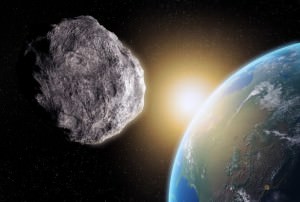Massive Asteroid to Pass by Earth on May 31
Radar telescopes to help determine characteristics of celestial object.
Staff writer: Corinne Sato
A giant asteroid will be coming close to Earth on May 31. In a press release, NASA has stated that, “Asteroid 1998 QE2 will sail past Earth, getting no closer than about 5.8 million kilometers, or about 15 times the distance between the Earth and the moon.”
While the 1998 QE2 will not be of much interest to astronomers looking for hazardous asteroids, the NASA press release says, “it is of interest to those who dabble in radar astronomy and have a 70-meter – or larger – radar telescope at their disposal.”
Of course, NASA has not one, but two radar telescopes that will be observing the asteroid.
“Between May 30 and June 9, radar astronomers using NASA’s 70 meter Deep Space Network antenna at Goldstone, California and the Arecibo Observatory in Puerto Rico, are planning an extensive campaign of observations,” it explains.
“The two telescopes have complementary imaging capabilities that will enable astronomers to learn as much as possible about the asteroid during its brief visit near Earth.”
According to Lance Benner, radar astronomer, “Asteroid 1998 QE2 will be an outstanding radar imaging target at Goldstone and Arecibo and we expect to obtain a series of high-resolution images that could reveal a wealth of surface features.”
[pullquote]Actually, “this is going to be one of the best radar targets” of the year, says the Goldstone Radar Observations Planning Website. [/pullquote]
What makes radar technology so important?
On the Asteroid Radar Research Website written by Stephen J. Ostro, “radar is a uniquely powerful source of information about asteroid physical properties and orbits.”
Radar measures different frequencies which produce two-dimensional images.
“With adequate orientational coverage, such images can be used to construct geologically detailed three-dimensional models,” Ostro says.
“Whenever an asteroid approaches this closely, it provides an important scientific study to study it in detail to understand its size, shape, rotation, surface features and what they can tell us about its origin,” Benner adds.
[pullquote]“It is tremendously exciting to see detailed images of this asteroid for the first time,” [/pullquote]Benner says. “With radar we can transform an object from a point of light into a small world with its own unique set of characteristics.”
With radar technology, NASA will not only be able to learn more about characteristics of asteroids, but it may also be able to help scientists to determine if asteroids will hit the Earth or not, Ostro says.
Sources
(285263) 1998 QE2 Goldstone Radar Observations Planning Website
Photo courtesy to website redOrbit
Corinne Sato is a freelance journalist and photographer, who likes to bake, cook and travel.
























Share the post "Massive Asteroid to Pass by Earth on May 31"